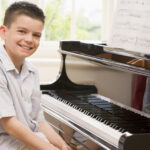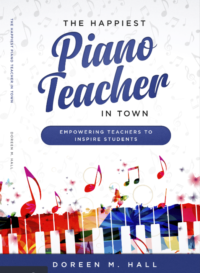
Learning Piano Scales and Arpeggios the Easy Way
In the last blog post “Convincing Kids to Play Piano Scales & Arpeggios” I wrote about explaining to students why playing scales and arpeggios is important for aspiring pianists. Hopefully, this explanation will help students to get on board. I am not talking about kids jumping for joy at the idea of playing scales, but at least having a willingness to practice and memorize them. This is how I make learning piano scales and arpeggios as pain-free as possible for my students:
Where to begin
I started teaching piano scales & arpeggios at the end of book 1 of the Paloma Method (when I used other methods I would also wait until the student could read some music and play with hands together). I consistently follow these steps when teaching scales and arpeggios:
1. I start with the C major scale two octaves, hands separately. I never teach one-octave scales. I think it’s pointless. The pianists’ standard for exams and auditions is the four-octave scale, learning two octaves from the start makes it easy to play three and four-octave scales (or arpeggios). I write my scales out as follows to make them easier for my students to learn;

2. When teaching scales I ask my students to pay super careful attention to technique, i.e. arms parallel to the keyboard, hands relaxed (especially the fifth finger), thumbs travel smoothly under the hand.
3. Once my student can play the two-octave scale well, hands alone she begins putting the hands together. We do this during the lesson and I make sure that my student can play hands together before she leaves my studio. I know that if I leave it up to my student to learn hands together at home she probably won’t. If all she has to do is practice what she already knows how to do she probably will. I always drill into all of my students the importance of daily practice especially on the day of the lesson and again on the following day! No waiting a couple of days to practice
4. When my student can play the C major scale two octaves hands together memorized at a decent steady tempo (eighth notes at 80 bpm) I have her learn G major in the same manner and then follow the Circle of Fifths. The reason for this is two-fold, the first five scales have identical fingering with third fingers always playing at the same time and Bb through Db have the same left-hand fingering. This is also a great way to reinforce key signatures.
In my studio scales always take place at the end of the lesson unless I have a student who just refuses to practice them all together, at which time I move them to the beginning of the lesson.
As my students are learning the scales we constantly review the ones they already know. For example, my students know that if they are on the B scale I may ask for them to G scale as well at that lesson. Also, I will ask them to play the Ab scale if they are studying a piece in that key. Once in a while, we will just have a “scale review day”. This is usually when a student has had a busy week and not much time to practice or when a break is coming up and I want to wait to begin work on a new piece. I always try to make it fun. My goal is to give the students a chance to practice in the studio which I know they would rather not practice at home.
After my students have learned all of the major scales (two octaves hands together) we start on the arpeggios (also two octaves hands together). I teach the arpeggios in the same order as the scales. The students review the corresponding scale while learning each arpeggio.
That’s pretty much it. At some point, I ask my students to turn two-octave piano scales & arpeggios into three and then four-octaves. Once all major scales and arpeggio are learned I just keep reviewing them, forever. At the end of every lesson, I assign next week’s review scale and arpeggio. This is as painless as I can make it.
So what about metronome studies and the minor scales? I teach these only to early-advanced and advanced students or students who need to learn them for auditions or exams. Although the vast majority of my students are not studying piano to become professional pianists, I absolutely want to teach so that every one of them has the option of a career in music if they should so decide on one somewhere along the way.
In a perfect world, my students would focus more on piano scales & arpeggios. Most of them would spend more time practicing overall. But the fact is, I only see my students for 30 minutes per week and all of them have lots of other things going on in their lives.
The end game.
This method of learning scales & arpeggios fits well with my personal teaching philosophy. I believe learning to play the piano should be enjoyable. I want to balance gearing lessons to meet individual student goals with guiding them to become lifelong pianists and well-rounded musicians. That’s why I think it’s a good idea to learn piano scales and arpeggios the easy way.
You can find free Major Piano Scale & Arpeggios sheets right here at Paloma Piano.
Read this post Convincing Kids to Play Piano Scales & Arpeggios
Not a member yet?
Join our email list.
sign up
Visit our sister site for students and parents pianoparents.net
Get my book. “The Happiest Piano Teacher in Town, Empowering Teachers to Inspire Students”
If you would like to find out about becoming a member of Paloma Piano we have a number of very attractive membership options including a free membership that offers a large number of piano scores, teaching resources, and games. The free membership is forever free and no credit card is needed. Check it out!
You can explore all of our free materials here.



I lоve your blog.. very informative. Great ideas!
kudos